Xueyan Zou
EgoVLA: Learning Vision-Language-Action Models from Egocentric Human Videos
Jul 16, 2025Abstract:Real robot data collection for imitation learning has led to significant advancements in robotic manipulation. However, the requirement for robot hardware in the process fundamentally constrains the scale of the data. In this paper, we explore training Vision-Language-Action (VLA) models using egocentric human videos. The benefit of using human videos is not only for their scale but more importantly for the richness of scenes and tasks. With a VLA trained on human video that predicts human wrist and hand actions, we can perform Inverse Kinematics and retargeting to convert the human actions to robot actions. We fine-tune the model using a few robot manipulation demonstrations to obtain the robot policy, namely EgoVLA. We propose a simulation benchmark called Isaac Humanoid Manipulation Benchmark, where we design diverse bimanual manipulation tasks with demonstrations. We fine-tune and evaluate EgoVLA with Isaac Humanoid Manipulation Benchmark and show significant improvements over baselines and ablate the importance of human data. Videos can be found on our website: https://rchalyang.github.io/EgoVLA
Visual Acoustic Fields
Apr 01, 2025Abstract:Objects produce different sounds when hit, and humans can intuitively infer how an object might sound based on its appearance and material properties. Inspired by this intuition, we propose Visual Acoustic Fields, a framework that bridges hitting sounds and visual signals within a 3D space using 3D Gaussian Splatting (3DGS). Our approach features two key modules: sound generation and sound localization. The sound generation module leverages a conditional diffusion model, which takes multiscale features rendered from a feature-augmented 3DGS to generate realistic hitting sounds. Meanwhile, the sound localization module enables querying the 3D scene, represented by the feature-augmented 3DGS, to localize hitting positions based on the sound sources. To support this framework, we introduce a novel pipeline for collecting scene-level visual-sound sample pairs, achieving alignment between captured images, impact locations, and corresponding sounds. To the best of our knowledge, this is the first dataset to connect visual and acoustic signals in a 3D context. Extensive experiments on our dataset demonstrate the effectiveness of Visual Acoustic Fields in generating plausible impact sounds and accurately localizing impact sources. Our project page is at https://yuelei0428.github.io/projects/Visual-Acoustic-Fields/.
M3: 3D-Spatial MultiModal Memory
Mar 20, 2025Abstract:We present 3D Spatial MultiModal Memory (M3), a multimodal memory system designed to retain information about medium-sized static scenes through video sources for visual perception. By integrating 3D Gaussian Splatting techniques with foundation models, M3 builds a multimodal memory capable of rendering feature representations across granularities, encompassing a wide range of knowledge. In our exploration, we identify two key challenges in previous works on feature splatting: (1) computational constraints in storing high-dimensional features for each Gaussian primitive, and (2) misalignment or information loss between distilled features and foundation model features. To address these challenges, we propose M3 with key components of principal scene components and Gaussian memory attention, enabling efficient training and inference. To validate M3, we conduct comprehensive quantitative evaluations of feature similarity and downstream tasks, as well as qualitative visualizations to highlight the pixel trace of Gaussian memory attention. Our approach encompasses a diverse range of foundation models, including vision-language models (VLMs), perception models, and large multimodal and language models (LMMs/LLMs). Furthermore, to demonstrate real-world applicability, we deploy M3's feature field in indoor scenes on a quadruped robot. Notably, we claim that M3 is the first work to address the core compression challenges in 3D feature distillation.
LoRA-TTT: Low-Rank Test-Time Training for Vision-Language Models
Feb 04, 2025Abstract:The rapid advancements in vision-language models (VLMs), such as CLIP, have intensified the need to address distribution shifts between training and testing datasets. Although prior Test-Time Training (TTT) techniques for VLMs have demonstrated robust performance, they predominantly rely on tuning text prompts, a process that demands substantial computational resources and is heavily dependent on entropy-based loss. In this paper, we propose LoRA-TTT, a novel TTT method that leverages Low-Rank Adaptation (LoRA), applied exclusively to the image encoder of VLMs. By introducing LoRA and updating only its parameters during test time, our method offers a simple yet effective TTT approach, retaining the model's initial generalization capability while achieving substantial performance gains with minimal memory and runtime overhead. Additionally, we introduce a highly efficient reconstruction loss tailored for TTT. Our method can adapt to diverse domains by combining these two losses, without increasing memory consumption or runtime. Extensive experiments on two benchmarks, covering 15 datasets, demonstrate that our method improves the zero-shot top-1 accuracy of CLIP-ViT-B/16 by an average of 5.79% on the OOD benchmark and 1.36% on the fine-grained benchmark, efficiently surpassing test-time prompt tuning, without relying on any external models or cache.
Integrating LMM Planners and 3D Skill Policies for Generalizable Manipulation
Jan 30, 2025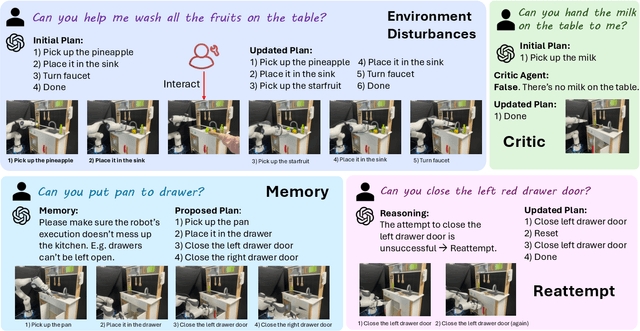
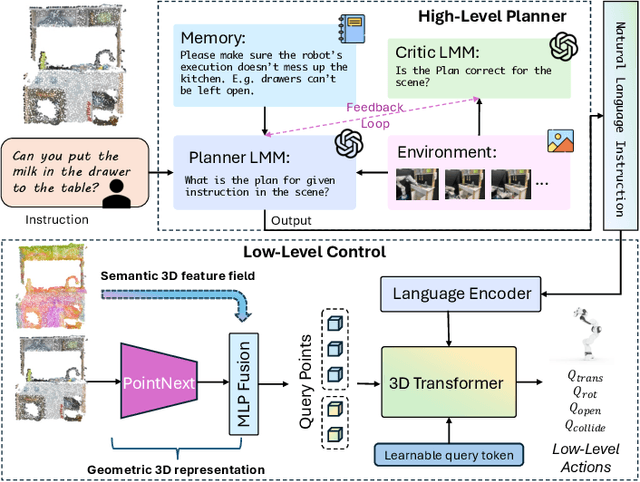

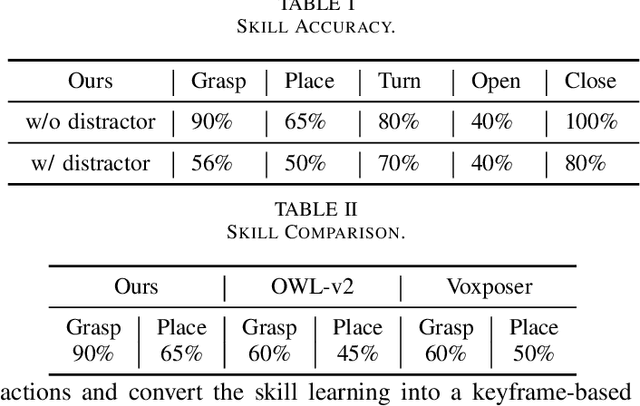
Abstract:The recent advancements in visual reasoning capabilities of large multimodal models (LMMs) and the semantic enrichment of 3D feature fields have expanded the horizons of robotic capabilities. These developments hold significant potential for bridging the gap between high-level reasoning from LMMs and low-level control policies utilizing 3D feature fields. In this work, we introduce LMM-3DP, a framework that can integrate LMM planners and 3D skill Policies. Our approach consists of three key perspectives: high-level planning, low-level control, and effective integration. For high-level planning, LMM-3DP supports dynamic scene understanding for environment disturbances, a critic agent with self-feedback, history policy memorization, and reattempts after failures. For low-level control, LMM-3DP utilizes a semantic-aware 3D feature field for accurate manipulation. In aligning high-level and low-level control for robot actions, language embeddings representing the high-level policy are jointly attended with the 3D feature field in the 3D transformer for seamless integration. We extensively evaluate our approach across multiple skills and long-horizon tasks in a real-world kitchen environment. Our results show a significant 1.45x success rate increase in low-level control and an approximate 1.5x improvement in high-level planning accuracy compared to LLM-based baselines. Demo videos and an overview of LMM-3DP are available at https://lmm-3dp-release.github.io.
NaVILA: Legged Robot Vision-Language-Action Model for Navigation
Dec 05, 2024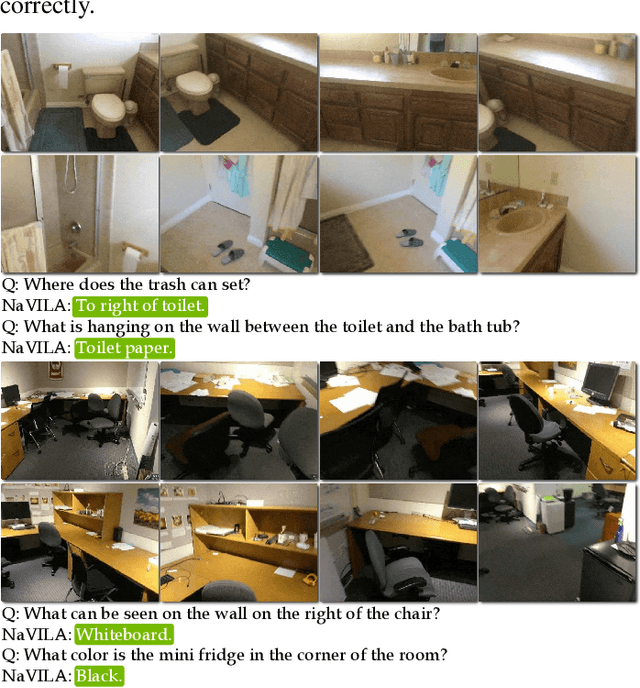
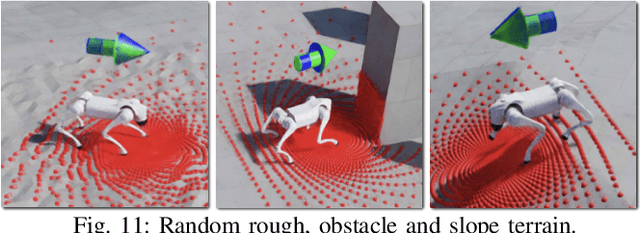


Abstract:This paper proposes to solve the problem of Vision-and-Language Navigation with legged robots, which not only provides a flexible way for humans to command but also allows the robot to navigate through more challenging and cluttered scenes. However, it is non-trivial to translate human language instructions all the way to low-level leg joint actions. We propose NaVILA, a 2-level framework that unifies a Vision-Language-Action model (VLA) with locomotion skills. Instead of directly predicting low-level actions from VLA, NaVILA first generates mid-level actions with spatial information in the form of language, (e.g., "moving forward 75cm"), which serves as an input for a visual locomotion RL policy for execution. NaVILA substantially improves previous approaches on existing benchmarks. The same advantages are demonstrated in our newly developed benchmarks with IsaacLab, featuring more realistic scenes, low-level controls, and real-world robot experiments. We show more results at https://navila-bot.github.io/
WildLMa: Long Horizon Loco-Manipulation in the Wild
Nov 22, 2024



Abstract:`In-the-wild' mobile manipulation aims to deploy robots in diverse real-world environments, which requires the robot to (1) have skills that generalize across object configurations; (2) be capable of long-horizon task execution in diverse environments; and (3) perform complex manipulation beyond pick-and-place. Quadruped robots with manipulators hold promise for extending the workspace and enabling robust locomotion, but existing results do not investigate such a capability. This paper proposes WildLMa with three components to address these issues: (1) adaptation of learned low-level controller for VR-enabled whole-body teleoperation and traversability; (2) WildLMa-Skill -- a library of generalizable visuomotor skills acquired via imitation learning or heuristics and (3) WildLMa-Planner -- an interface of learned skills that allow LLM planners to coordinate skills for long-horizon tasks. We demonstrate the importance of high-quality training data by achieving higher grasping success rate over existing RL baselines using only tens of demonstrations. WildLMa exploits CLIP for language-conditioned imitation learning that empirically generalizes to objects unseen in training demonstrations. Besides extensive quantitative evaluation, we qualitatively demonstrate practical robot applications, such as cleaning up trash in university hallways or outdoor terrains, operating articulated objects, and rearranging items on a bookshelf.
GraspSplats: Efficient Manipulation with 3D Feature Splatting
Sep 03, 2024



Abstract:The ability for robots to perform efficient and zero-shot grasping of object parts is crucial for practical applications and is becoming prevalent with recent advances in Vision-Language Models (VLMs). To bridge the 2D-to-3D gap for representations to support such a capability, existing methods rely on neural fields (NeRFs) via differentiable rendering or point-based projection methods. However, we demonstrate that NeRFs are inappropriate for scene changes due to their implicitness and point-based methods are inaccurate for part localization without rendering-based optimization. To amend these issues, we propose GraspSplats. Using depth supervision and a novel reference feature computation method, GraspSplats generates high-quality scene representations in under 60 seconds. We further validate the advantages of Gaussian-based representation by showing that the explicit and optimized geometry in GraspSplats is sufficient to natively support (1) real-time grasp sampling and (2) dynamic and articulated object manipulation with point trackers. With extensive experiments on a Franka robot, we demonstrate that GraspSplats significantly outperforms existing methods under diverse task settings. In particular, GraspSplats outperforms NeRF-based methods like F3RM and LERF-TOGO, and 2D detection methods.
PLUM: Preference Learning Plus Test Cases Yields Better Code Language Models
Jun 11, 2024Abstract:Instruction-finetuned code language models (LMs) have shown promise in various programming tasks. They are trained, using a language modeling objective, on natural language instructions and gold code snippet pairs. Recent evidence suggests that these models, never exposed to incorrect solutions during training, often struggle to distinguish between correct and incorrect solutions. This observation raises our inquiry: Can preference learning, which trains models to prefer correct solutions over incorrect ones, help push the boundaries of code LMs even further? We propose PLUM, a novel \textbf{p}reference \textbf{l}earning framework a\textbf{u}gmented with test cases tailored for code L\textbf{M}s.PLUM aims to investigate the key success factors and potential benefits of preference learning in code LMs, which remain elusive despite its success in aligning LMs with human values. PLUM consists of three stages: (1) Generating test cases for natural language instructions, (2) sampling candidate solutions from the policy and evaluating them against the test cases to create a preference dataset, which is then used to (3) train the policy with a preference learning algorithm. Experiments demonstrate that PLUM substantially improves the performance of existing code LMs on established code generation benchmarks such as HumanEval (+) and MBPP (+), even for the state-of-the-art open-source language model CodeQwen-1.5-7B-Chat. PLUM complements the supervised fine-tuning (SFT) stage, demonstrating synergistic effects.
Interfacing Foundation Models' Embeddings
Dec 12, 2023Abstract:We present FIND, a generalized interface for aligning foundation models' embeddings. As shown in teaser figure, a lightweight transformer interface without tuning any foundation model weights is enough for a unified image (segmentation) and dataset-level (retrieval) understanding. The proposed interface has the following favorable attributes: (1) Generalizable. It applies to various tasks spanning retrieval, segmentation, \textit{etc.}, under the same architecture and weights. (2) Prototypable. Different tasks are able to be implemented through prototyping attention masks and embedding types. (3) Extendable. The proposed interface is adaptive to new tasks, and new models. (4) Interleavable. With the benefit of multi-task multi-modal training, the proposed interface creates an interleaved shared embedding space. In light of the interleaved embedding space, we introduce the FIND-Bench, which introduces new training and evaluation annotations to the COCO dataset for interleave segmentation and retrieval. Our approach achieves state-of-the-art performance on FIND-Bench and competitive performance on standard retrieval and segmentation settings. The training, evaluation, and demo code as well as the dataset have been released at https://github.com/UX-Decoder/FIND.
 Add to Chrome
Add to Chrome Add to Firefox
Add to Firefox Add to Edge
Add to Edge